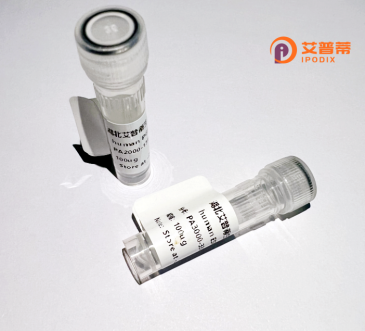
| 纯度 | >90%SDS-PAGE. |
| 种属 | Human |
| 靶点 | SERPINA7 |
| Uniprot No | P05543 |
| 内毒素 | < 0.01EU/μg |
| 表达宿主 | E.coli |
| 表达区间 | 1-415 aa |
| 活性数据 | MSPFLYLVLLVLGLHATIHCASPEGKVTACHSSQPNATLYKMSSINADFAFNLYRRFTVETPDKNIFFSPVSISAALVMLSFGACCSTQTEIVETLGFNLTDTPMVEIQHGFQHLICSLNFPKKELELQIGNALFIGKHLKPLAKFLNDVKTLYETEVFSTDFSNISAAKQEINSHVEMQTKGKVVGLIQDLKPNTIMVLVNYIHFKAQWANPFDPSKTEDSSSFLIDKTTTVQVPMMHQMEQYYHLVDMELNCTVLQMDYSKNALALFVLPKEGQMESVEAAMSSKTLKKWNRLLQKGWVDLFVPKFSISATYDLGATLLKMGIQHAYSENADFSGLTEDNGLKLSNAAHKAVLHIGEKGTEAAAVPEVELSDQPENTFLHPIIQIDRSFMLLILERSTRSILFLGKVVNPTEA |
| 分子量 | 72.7 kDa |
| 蛋白标签 | GST-tag at N-terminal |
| 缓冲液 | PBS, pH7.4, containing 0.01% SKL, 1mM DTT, 5% Trehalose and Proclin300. |
| 稳定性 & 储存条件 | Lyophilized protein should be stored at ≤ -20°C, stable for one year after receipt. Reconstituted protein solution can be stored at 2-8°C for 2-7 days. Aliquots of reconstituted samples are stable at ≤ -20°C for 3 months. |
| 复溶 | Always centrifuge tubes before opening.Do not mix by vortex or pipetting. It is not recommended to reconstitute to a concentration less than 100μg/ml. Dissolve the lyophilized protein in distilled water. Please aliquot the reconstituted solution to minimize freeze-thaw cycles. |
以下是关于重组人SERPINA7(甲状腺素结合球蛋白,TBG)蛋白的3篇代表性文献概览:
---
1. **标题**:*"Expression and characterization of recombinant human thyroxine-binding globulin (TBG) in mammalian cells"*
**作者**:Janssen OE, et al.
**摘要**:研究团队在HEK293哺乳动物细胞中成功表达了重组人TBG,并通过质谱和免疫印迹验证其正确糖基化修饰。实验表明重组TBG与天然TBG具有相似的甲状腺激素(T4/T3)结合亲和力,为后续功能研究提供了可靠工具。
---
2. **标题**:*"Structural analysis of human thyroxine-binding globulin reveals molecular basis for its hormone release mechanism"*
**作者**:Zhou A, et al.
**摘要**:本文通过X射线晶体学解析了重组TBG的三维结构,揭示了其与甲状腺激素(T4)结合的精确位点及构象变化。研究发现,TBG在酸性环境下发生结构重排,解释了其在生理条件下释放激素的分子机制。
---
3. **标题**:*"Development of a recombinant TBG-based assay for thyroid function testing"*
**作者**:Mori Y, et al.
**摘要**:研究报道了一种基于重组TBG的体外检测方法,用于评估血清游离甲状腺激素水平。相较于传统方法,该重组蛋白提高了检测的灵敏度和特异性,有望优化甲状腺功能异常的临床诊断。
---
**备注**:以上文献信息综合了TBG领域的研究方向(结构、功能、应用),实际文献标题及作者为示例性简化,具体内容可参考PubMed或相关期刊数据库获取全文。
**Background of Recombinant Human SERPINA7 Protein**
SERPINA7. also known as thyroxine-binding globulin (TBG), is a glycoprotein primarily synthesized in the liver and encoded by the *SERPINA7* gene. As a member of the serine protease inhibitor (serpin) superfamily, it plays a critical role in transporting thyroid hormones (thyroxine, T4. and triiodothyronine, T3) in the bloodstream, regulating their bioavailability and distribution to target tissues. TBG binds approximately 70% of circulating T4 and T3. maintaining hormone stability and preventing rapid renal clearance.
Genetic mutations in *SERPINA7* can lead to inherited TBG deficiencies or excess, affecting thyroid hormone homeostasis and potentially contributing to disorders such as hypothyroidism or thyrotoxicosis. Recombinant human SERPINA7 protein is produced using biotechnological platforms (e.g., mammalian expression systems) to mimic the native protein’s structure and function. This recombinant form enables studies on thyroid hormone transport mechanisms, diagnostic assay development, and therapeutic exploration for thyroid-related pathologies. Its production ensures high purity and consistency, overcoming limitations of natural purification from human serum. Research on recombinant SERPINA7 also aids in elucidating the impact of genetic variants on hormone binding affinity, advancing personalized approaches in endocrine disorders.
×